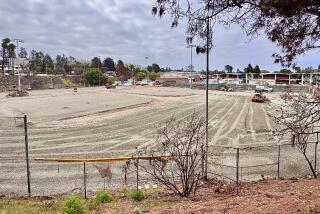Finding Belmont’s Roots
- Share via
As the seemingly endless controversy over the Belmont Learning Complex continues, it’s important that the essential outrage not be lost: The building of this school was carried out in the most inept, wrongheaded and quite possibly criminal way possible.
Whether other schools and institutions are also sited in dangerous spots in old oil fields is certainly a discussion that the Los Angeles Board of Education and other officials should have. But they must not lose sight of the unique nature of the Belmont fiasco: In its planning and execution, in the legal advice and political maneuvering, whatever could go wrong did, and the taxpayers are now left holding the bag for up to $265 million. It is important that the people responsible face real and concrete consequences, whether or not the board pulls the plug on this project.
The board knows what is at stake. State inquiries and tests have pinpointed the environmental problems on the Belmont site, from poisonous gases to the danger of explosion, and raised questions about the deal. An investigation by the Los Angeles Unified School District’s hard-hitting chief auditor, Don Mullinax, named names and identified mismanagement, negligence and damaging conflicts of interest.
More ammunition is expected in a second Mullinax report, due next month, that promises to follow the money and identify who got paid and whether the job was completed or done properly. The additional information should prove useful in the board’s attempts to recover some of the millions wasted on the project.
Many should pay for the bad legal advice, sweetheart deal-making, ignorance of environmental requirements and plundering of public dollars. The discoveries of poor leadership and mismanagement have already forced out district general counsel Richard Mason and Chief Administrative Officer David Koch. Supt. Ruben Zacarias will leave on Jan. 15. Six other employees await disciplinary hearings, and the new chief operating officer, Howard Miller, plans additional steps to strengthen financial controls and real estate expertise. However, former Supt. Sid Thompson and others such as retired development director Dominic Shambra have so far escaped responsibility.
District staff recommendations about the site are also due next month, and next summer the state Department of Toxic Substances Control, an agency that has the power to veto the opening of the school, will issue its final report.
Why was the school sited on a steeply sloped abandoned oil field contaminated with potentially explosive methane and toxic hydrogen sulfide? One reason was that former boards decided they didn’t want to make room for new schools by tearing down aging housing, so they chose industrial land. It sounds compassionate, but as usual for Los Angeles’ former school boards, it wasn’t thought through. The unintended consequence at Belmont is that it could cost up to $60 million to mitigate the site’s dangers. How much replacement housing might $60 million have bought?
The latest frustration stems from the failure of the developer, Temple Beaudry Partners, to meet the board’s Nov. 23 deadline to secure the nearly completed buildings against wind, rain and vagrants while construction is suspended. The board had extended the deadline several times and budgeted $2.75 million to board up windows, seal walls and take other steps to protect the public investment. The Belmont project director, hired by the school district to supervise construction, put the developer on notice two weeks ago about the lack of progress. Today, that work remains unfinished. The district might even have to hire another contractor to complete the work in a race against bad weather.
The Belmont Learning Complex was supposed to benefit high school students who have been bused to distant campuses or stuck in overcrowded schools for too long. With the drip-drip-drip of revelation about Belmont, the old ways of doing business in the LAUSD become more untenable. By tenaciously fixing responsibility for such a major boondoggle, the board can signal its intention to do things differently.
More to Read
Sign up for Essential California
The most important California stories and recommendations in your inbox every morning.
You may occasionally receive promotional content from the Los Angeles Times.













